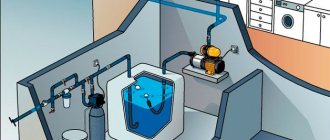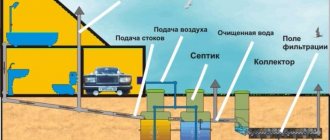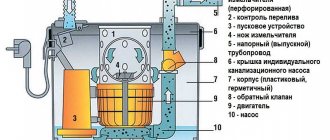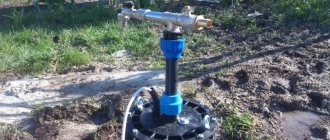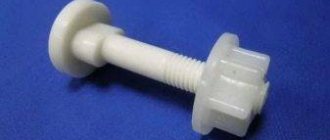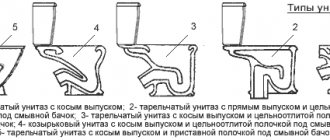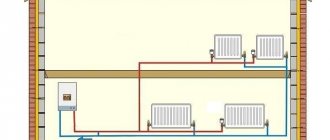The task of the circulation pump is to drive the coolant along the entire line of pipes through the boiler with the most efficiently configured operating parameters. An incorrectly selected device will reduce the efficiency of the system, the water circulation will be less efficient, and the heating will be weak and slow. If the device is too powerful, excessive consumption of electricity is possible. It is necessary to pay attention to noise level, acceptable level of complexity of maintenance and repair. The pump must be installed and adjusted correctly. Let's look at how circulation pumps are selected, characteristics, stages and installation requirements, and how to install them.
General information
Previously, all houses installed a system through which the working environment moved naturally. The movement of water was ensured by heating it in a boiler or even an ordinary furnace. It cooled in the radiators and other elements of the building’s thermal circuit, after which it was returned to the heating equipment. It was according to this simple scheme that it circulated through the pipes.
Nowadays additional equipment is used everywhere. Before installing a pump in a heating system in a private home, specialists perform calculations and select a device, taking into account the characteristics of the building’s thermal circuit. Professionals also take other nuances into account.
On a note! A thermal circuit with natural circulation is just a relatively simple heating circuit. After all, when installing it, pipes must be laid with a slope, batteries are mounted in strictly specified places, and pipelines of exceptionally large diameter are used. In some buildings, all the rules are difficult or impossible to comply with. Therefore, it is not possible to ensure the required coolant circulation through the system.
Conventional diagram of the thermal circuit of a building with natural movement of coolant Source rtkpipe.ru
Professional installation of additional equipment allows you to solve these problems. Most homeowners turn to specialists for help. After all, they know very well how to properly install a circulation pump in a heating system.
The optimal sequence of actions if there is a problem with part of the pipeline in the apartment
The proposed solutions require a lot of time to maintain the system. It is much easier to find the main cause and quickly eliminate it, thereby returning normal pressure. Sometimes you can find a problem area on a water supply by the humming sound. At a problem point where the flow of water slows down, a hum is created when the mixer is opened. If you listen, you can immediately diagnose the problem and not waste time on unnecessary maintenance.
When it is not possible to determine the cause by ear, you should begin servicing the system. The first thing you can do is clean the aerator at the tip of the faucets. Before this, if you unscrew their flexible connection, you can see the current of water supplied to the tap. If it is normal, then changing the valve axle boxes and washing the aerators will solve the problem.
This is what a clogged aerator looks like
When the reason is not in the taps and flexible connections, then you need to look for it at the level of the meter and other fittings. Ideally, immediately contact the management company to remove the seals from it. After their dismantling, you can begin full-fledged maintenance, which was not available before, since the seal wire prevents the disassembly of many important components.
Then you can proceed according to this scheme:
- Disassemble the coarse filter and wash or replace its mesh.
- Check the pressure before and after the meter, it may be jammed and should be replaced.
- In a similar way, evaluate the operation of the check valve and replace it if necessary.
- Conduct diagnostics of ball valves and, if they fail, replace them.
If all else fails, then the reason is the pipes, which will have to be changed. This requires a tool, so you will have to call a plumber. If you plan to install metal-plastic pipes, you can do the soldering yourself by renting the equipment. This service is offered in many major cities.
Ball valve, oblique filter and counter are problem areas accumulating calcium salts
The advantage of a system with a pump
Opponents of heating, characterized by forced movement of the medium, note the following disadvantages:
- installing a circulation pump forces you to increase the cost of installing a heating circuit;
- equipment requires an electrical connection, which causes additional costs for electricity;
- the efficient operation of the pumping unit depends on the stability of the power supply, which does not exclude the occurrence of emergency situations if the power supply is interrupted;
- installing an electric pump forces the installation of the entire unit and its regular maintenance, but even in this case it is not protected from breakdowns.
Pumping unit in the heating network of a house Source sovet-ingenera.com
Upon closer examination of each non-delivery, the disadvantages turn out to be not as significant as they seem at first. Moreover, to organize the effective operation of a thermal circuit with gravitational movement of the coolant, one cannot do without certain knowledge, experience, and the implementation of specific rules. Therefore, for its proper installation, you will need the help of specialists who also know perfectly well how to properly install a heating pump in a private home.
To finally find out all the advantages of having a circulation pump unit in the thermal circuit of a building, you need to become more familiar with the system where the coolant moves by gravity.
Schematic diagram of a gravity heating circuit Source oboiman.ru
After determining the installation location of the boiler, be sure to lay a vertical pipeline. It is the accelerating section of the system. For its arrangement, pipes with a large diameter are used. It is recommended to install pipes with a cross-section of at least 1.5 inches.
The acceleration pipeline is laid to the maximum possible height. It should be mounted to a point that is higher than all the radiators in the house. After this, the expansion tank is secured and connected. This device usually has an open design.
The coolant supply pipeline from the expansion tank is laid with a slope of at least 5%. In other words, the slope of the pipe must be at least 50 mm per 1 m. In this case, its cross-sectional size must be at least 1.25 inches.
Descents to radiators are made of pipes with a minimum diameter of 3/4 inch. The return manifold, which is also placed on a slope, is made of rolled pipe with the same cross-section as that of the upper supply pipeline.
Gravity-flow system with an open tank for expansion of the working medium and an accelerating pipe Source tvoya-stroika.ru
Such a heating device with gravity flow forces the boiler to be installed below the radiators. This is not always convenient or possible. In addition, the length of pipelines is increasing. To avoid all the inconveniences, turn to specialists who know very well how to install a circulation pump in the heating system of a private home. After all, it is this that will allow the supply of heated water to the battery at any point in the building.
It is still possible to implement a gravity circuit in small houses where all heated rooms are nearby. However, even with this arrangement of rooms, it is not always possible to install a system with gravitational circulation.
The need to use pipes with a large cross-section makes it necessary to spend more money on organizing heating. Such pipelines are more difficult to install and very difficult to hide in building structures, and sometimes this cannot be done at all. At the same time, professional installation of a pump in a heating system will cost less than the cost of installing a gravity circuit with large pipes and many associated costs.
Pump in the heating circuit of a house Source onlinetrade.ru
Another disadvantage of the gravity system is the inability to conceal the bottom connection of the batteries. This cannot be done even if the project is developed by experienced designers. In a circuit with coolant gravity flow, it will not be possible to create a pressure greater than 0.6 atm. After all, it is formed in the system due to temperature changes and due to different densities of the liquid.
Important! Pressure 0.6 atm. not enough for modern radiators. In addition, you can forever forget about water-heated floors, which are always installed correctly by specialists. However, for them to work effectively, you will need to install a heating pump. If the device is professionally selected, it will always create the required pressure.
An electric pump to create and maintain the required pressure Source leroymerlin.ru
In order for the gravitational circuit to operate at its designed power, it needs a starting impulse. It can only be obtained by increasing energy resources. If even a short shutdown of the boiler unit occurs, then it will take a long time to bring the heating circuit back to normal operation.
In addition, in a gravity circulation system, fluid moves slowly. Its movement is carried out due to the energy of the boiler, and this reduces the efficiency of the unit and the entire intra-house heating circuit. All these problems can be solved by installing a circulation pump for heating - professionals will help you how to install the unit correctly.
Important! Even inexpensive circulation equipment consumes a maximum of 90 W per hour. More expensive models have lower characteristics. It is significantly less than the total energy consumption that will occur when operating heating with gravitational movement of the coolant.
Characteristics, including power, of common circulation units Source 1-teplodom.ru
See also: Catalog of companies that specialize in engineering systems (heating, water supply, sewerage and others) and related work
The low speed of the working medium in the gravitational system is one of the reasons for uneven heating of radiators. In this situation, the heat transfer of the batteries can only be regulated by changing the amount of coolant that passes through them. However, this method will not allow for precise adjustment.
If we take into account that the pressure in the circuit is still low, then there is a high probability of blockage of one of the batteries in the house or even an entire section of the system. In this case, you should completely forget about the possibility of mixing coolant from the return pipeline. Therefore, you shouldn’t even think about high-quality regulation of heat transfer from heating devices.
The conclusion is that the gravitational circuit is not an effective system. Its arrangement leads to irrational consumption of energy resources. Therefore, it is better to spend money once on installing additional equipment than to pay large sums annually for the operation of an inefficient heating circuit. All owners of private residential buildings are recommended to contact professionals who know perfectly well how to install a heating pump in a private house.
Installing a pump in a heating system Source stroikairemont.com
The operation of the circulation pump completely depends on a stable supply of electrical energy. This problem is solved by installing an uninterruptible power supply. It can also simultaneously ensure the operation of the boiler unit. It all depends on its characteristics. Experts will also always help you in choosing a device.
On a note! Even an inexpensive UPS will allow boiler equipment to continue operating when problems arise with the central power supply.
If it is decided to connect a circulation pump, then the homeowner can consider switching the operation of the heating circuit to gravity circulation of the coolant. In most cases, experts offer just such a scheme to owners of modern houses. It involves installing a bypass. A pump and two valves are installed on it. The third shut-off valve is installed in the area that bypasses the bypass.
The advantages of the pump also include its durability if it is manufactured by a reputable company. Homeowners do not have to worry about the vulnerability of such equipment. Typically its service life is tens of years.
Most modern circulation pumps are durable equipment Source elektro56.ru
All pumping units must be serviced regularly to ensure they operate properly for many years. However, the benefits of such a device are undeniable. Therefore, even the purchase of an expensive pump is justified.
Main types of pumps for the heating circuit of a private house
Many well-known companies are engaged in the production of circulation pumps. For example, these are Wilo and Grundfos. Regardless of the brand, devices require electricity to operate. In the devices, the hydraulic and electrical parts are isolated from each other. This division is performed in two ways. The design of the pump depends on the specific option.
Dry type pumps
This type of pumping equipment is distinguished by the presence of a so-called dry rotor in its design. In such a device, the hydraulic part is completely separated from the electric drive. In this case, the impeller rotates due to the movement of the shaft around its axis.
Dry-type circulation pumping equipment Source simpalsmedia.com
Pumping equipment with a dry rotor has an elongated housing, since the electric motor is located on the side of the hydraulic unit. Due to this massive shape, a cantilever installation of the circulation pump in the heating system is performed. The installation process is simplified due to the presence of special brackets on the body. The equipment may also have an installation platform.
Pumping electrical appliances with a dry rotor are powerful devices with high performance. They are installed when it is necessary to supply a large amount of coolant. In addition, such pumping devices are capable of creating the necessary pressure to move liquid through extended systems. Therefore, their installation is carried out in large mansions with several floors.
Dry-type pumps have a number of disadvantages:
- Labor-intensive installation due to large dimensions.
- A complex sealing system on a rotating shaft that wears out during operation. Therefore, it is necessary to constantly carry out maintenance, and sometimes even change the sealing elements.
Dry-type pumping equipment with a complex sealing system Source yut-market.ru
- High noise level during operation, as the electric drive is cooled by air. Because of this feature, the installation of a circulation pump in a heating system in a private house is usually carried out in a boiler room, isolated from other rooms of the building.
Wet pumps
Pump circulation devices with a so-called wet rotor differ in design from electrical appliances of the “dry” type. First of all, their pump operating unit is connected to the power element hermetically due to the presence of ring gaskets between them. The two parts are screwed together.
The working unit has the shape of a snail. On both sides there are fastenings that allow connection to heating pipelines. Typically, manufacturers equip equipment with threaded pipes or flanges. The first elements allow coupling connections to be made.
Design of a household circulation pump Source superpumps.ru
The power section contains the stator winding. The pumped liquid never gets into it. To seal this part, the design contains a stainless steel glass. Therefore, the sealing elements are placed on fixed parts. Because of this, they do not wear out when the circulation pump for heating is running - specialists always know how to install it correctly.
An impeller is attached to its rotor shaft. These two parts are rigidly connected to each other. The bearings on which the rotor rests are lubricated with coolant. At the same time, it fills almost the entire space of the device. This allows heat to be effectively removed from the heating parts of the pump. Therefore, it does not overheat and does not need an additional cooling system.
Important! The “wet” type pumping device has an end plug that is used to remove air from the housing. This ensures that the entire device is completely filled with liquid.
At the end of the electric pump there is a plug for bleeding air. Source saucyintruder.org
When the rotor rotates in the working environment, energy losses occur. This reduces the efficiency of pumping equipment. However, this is a minor drawback, since the device consumes a minimal amount of electrical energy.
When operating a “wet” type electric pump, there is practically no noise. The device is easy to install and compact in size. However, you still need to know how to properly install the heating pump. After all, there is one important rule - the rotor axis must always be horizontal. In this case, the device body itself can occupy any position depending on its shape. If the rotor is positioned horizontally, then its bearings will always be wet, which prevents them from breaking due to excess heat.
Important! A filter is installed in front of the pump, which prevents solid particles from entering the bearings of the device.
Choosing a location for equipment
The pump or pumping station must be located in a specific location. This could be a caisson or a basement. The second option is most common. In this case, special attention must be paid to installation to avoid damage to the equipment due to possible rising water. In other words, the unit is fixed on a special stand away from the walls. It is important to take care of heating the basement.
If you choose a caisson, then this structure must also be insulated. Moreover, you should make sure that the depth at which the caisson will be installed is at least 2 m.
Basic selection parameters
Before connecting a circulation pump to the heating system, professionals select a device taking into account the features of the existing heating circuit of the house. During this process, they must pay attention to the following parameters of the device:
- The operating voltage should be 220 V. This characteristic allows you to connect the electric pump to a household power line. Therefore, there is no need to install separate wiring.
- Power – the optimal value is the minimum value. It is recommended to choose a device with power consumption class A. This device is the most economical. As the class decreases, power consumption increases.
Manufacturers produce modern pumping units with two or even three operating modes. They allow you to change the pressure of the pumped liquid. At the same time, the power of the device will change. These parameters are usually marked on the body of the electric pump.
Power connection
The circulation pumps operate from a 220 V network. The connection is standard; a separate power supply line with a circuit breaker is desirable. The connection requires three wires - phase, neutral and ground.
Circulation pump electrical connection diagram
The connection to the network itself can be organized using a three-pin socket and plug. This connection method is used if the pump comes with a connected power wire. It can also be connected via a terminal block or directly with a cable to the terminals.
The terminals are located under a plastic cover. We remove it by unscrewing several bolts and find three connectors. They are usually labeled (the pictograms are N - neutral wire, L - phase, and “ground” has an international designation), so it’s hard to make a mistake.
Where to connect the power cable
Since the entire system depends on the performance of the circulation pump, it makes sense to make a backup power supply - install a stabilizer with connected batteries. With such a power supply system, everything will work for several days, since the pump itself and the boiler automation “pulls” electricity to a maximum of 250-300 W. But when organizing, you need to calculate everything and select the battery capacity. The disadvantage of such a system is the need to ensure that the batteries do not discharge.
How to connect a circulator to electricity through a stabilizer
Installation of an electric circulation pump
Before starting installation work, each specialist already knows where to install the pump in the heating system - on the supply or return. Typically the installation is carried out on the return pipe. Installation is carried out directly in front of the boiler. In this case, it is better to choose a place after the tank in which the coolant expands.
On a note! It is recommended to install expansion tanks with a membrane in heating systems with quiet movement of the working medium. It is for this reason that the installation of electric pumps is carried out after them. After all, a device for circulating coolant contributes to the creation of flow turbulence.
If an open tank is installed, then the electric pump can be installed anywhere in the common return pipeline, but only after the last connection into it. The same recommendation applies to the membrane expansion tank. The location of the electric pump on the return line after the expansion tank extends the service life of the circulation device. Indeed, in this case it will pump a cooler coolant than when installed on the supply side.
Layout of the pump on the return after the expansion tank Source 1-teplodom.ru
Important! Modern pump models are designed to operate at a maximum temperature of 110°. This allows them to be installed on the supply pipeline. However, when choosing this option, you need to carefully balance all the parameters of the thermal circuit. After all, after the pumping unit, the working environment receives a vacuum. Taking this point into account, circulation devices should not be installed immediately behind the boiler, since when the heating circuit operates at maximum, boiling of the liquid in the batteries may occur. This situation poses a great danger.
Advice! If the pump is installed on a supply pipeline, then it must be installed at the greatest possible distance from the boiler unit.
Before connecting a circulation pump, professionals always first study the existing system. If branches extend from the central supply pipeline in different directions, pumping devices are installed on each of them. Such heating circuits are often found in buildings with extensions or in large houses that have two wings.
One of the options for a branched heating circuit with two circulation pumps for radiators and heated floors Source akak7.ru
In buildings with a branched thermal circuit, the optimal place to install the electric pump is the supply pipeline, but only after it has branched. In this case, the circulation device must be installed before the battery or the first riser.
When choosing a location for a circulation device, they are guided by the heating scheme in a particular house. There is no general rule for the placement of a device that pumps coolant. Specialists take into account the characteristics of a particular heating network and the availability of free space on its pipelines.
In addition, professionals control the location of the device’s rotor axis relative to the ground. It must always be parallel to the horizon. In addition, access to the electrical pump installation box is provided. After all, it is designed for connecting wires and there is a mode switch in it. Therefore, the installation box should not be located at the bottom of the device.
Pressure booster pump station
This solution is very convenient, but not very cheap, although there are inexpensive models (for example, Gilex Jumbo installations cost from $130). These installations can lift water from a well or borehole, but the suction hose can also be lowered into a tank. Then the storage tank can be placed anywhere, not necessarily at the top.
Their advantage is that the pressure is maintained constantly, without human intervention (as long as there is electricity). The main thing is to choose the right parameters. They can even be used to increase pressure when connected to a centralized water supply. If you have this option at your dacha:
- water is supplied through pipes, but its pressure is not enough even for a shower, not to mention other needs,
- The supply goes by the clock, and you cannot always be at the dacha at this time, and accordingly, everything remains without watering, and then there is no question of such a luxury as a shower. The issue of increasing pressure at the dacha can be solved with the help of a pumping station and a storage tank
Everything can be fixed by installing a large tank (1000 liters) and a pumping station. You will have a supply of water and a shower whenever you want. Such a container may not be enough for watering, but no one bothers to install a larger one or a slightly smaller one. Read about choosing and installing a pumping station here.
Features and installation procedure of the electric pump
To find out how to properly install a circulation pump, it is recommended to use the heating project. It is usually developed during the design stage of the house. If the heating circuit of a building is being modernized, then in this situation the best place to install the device is the bypass.
The presence of a jumper with an electric pump, filter and shut-off valves allows the heating network to function if the building loses power or an electrical appliance breaks down. Thanks to the bypass, it will be possible to switch the system to circulate the medium naturally. This will prevent you from being left completely without heat in the event of an emergency.
The bypass jumper can have almost any configuration. Often there is not enough space for installation. Therefore, non-standard solutions are being implemented. However, more often the installation is still carried out according to standard schemes.
One of the options for a bypass jumper for an electric heating pump Source e.allegroimg.com
If there is free space, a ready-made bypass assembly is usually installed. This design is manufactured in production shops. It is equipped with taps or valves are built into it. The finished bypass unit can be mounted by welding or connected via thread. Any such structure has a free area intended for installing an electric pump using flanges or couplings.
Thermal circuits in houses are often created from polypropylene pipes. This option simplifies the process of installing a circulation device for pumping coolant. The master usually spends about 1 hour on the work. More time is required if installation is carried out on metal pipes. It is necessary to use not only welding, but also packing of threaded connections.
During installation of the circulation pump, the technician carries out the following actions:
- prepares components - filter, shut-off valves, threaded pipes, drains;
- connects all threaded elements of the assembly using a special sealing tow and paste;
- assembles the loop together with the pump without carefully tightening the union nuts;
An assembled loop with a pump and a unit that is mounted underneath it Source 1-teplodom.ru
- outlines and cuts out an area on the return line for installing the tap;
- carries out welding work - first tacks the metal elements of the assembly, then removes the pump to prevent it from being damaged by welding splashes and completes the operations started;
- assembles the unit under the pump and carries out its installation;
- the circulation device is installed in place;
- carries out the final tightening of the American electrical appliance.
Important! On the electric pump, the direction of the arrow must coincide with the actual movement of the working medium in the heating pipeline.
At the end of the work, the master connects the wires. They are connected to the terminals located in the mounting box of the circulation device.
Technical characteristics and their meaning
First of all, you need to remember that the pump runs on electricity and needs a normal power supply. They are mostly voltage hungry. If, suddenly, the selected booster pump does not produce the required pressure, check the voltage. Perhaps it is low and the required operating power is simply not achieved.
The main technical characteristics that determine whether the pump that increases the pressure in the water supply system at the dacha will cope with the task is the maximum operating pressure. This is the value that the equipment can output.
The following characteristics are also important:
- Maximum feed. Shows how much water the pump can pump per unit of time. It is measured in liters per minute (l/min) or cubic meters per hour (mcub/hour). To make comparison more convenient, convert l/min to liters per hour - multiply the figure by 60, divide the resulting liters by 1000 and get cubic meters per hour. For example, we convert 30 l/min to cubic meters/hour: 30*60=1800 liters per hour, 1800/1000=1.8 m³/hour.
- Maximum pressure . This is the amount by which the booster pump can raise water relative to its installation location. This is important if the cottage has two floors or more, and the pump is installed, say, on the technical floor or basement.
Booster pump WILO PB-089 EA and its technical characteristics
Please note that the maximum values are usually indicated. To find out the real indicators, divide the stated parameters by 2. Then you definitely won’t go wrong.
It is important at what flow value the automatic booster pump for the dacha is turned on. The values may be different: 0.12 l/min and 0.3 l/min. This figure determines whether the pump will turn on when, for example, the toilet tank is filled, or whether it will start working only after the tap in the shower opens.
A few words about what modes the pump should operate to increase the pressure in the water supply system at the dacha. It is best to take those models that can work both manually and automatically. Here's why: not all analysis points create the flow required for automatic activation. If the device only has an automatic mode, you will not help the trouble. But if you can switch it to manual, turn it on before use and enjoy normal pressure. Just remember to turn it off.
An example of installing a vortex pump to increase water pressure in a country house
The next parameter is maximum and nominal power, measured in watts (W). Shows how efficient the motor drives the impeller. In principle, the more powerful the pump, the more pressure it can provide, but much still depends on the design and materials used.
Temperature of the working environment. Measured in degrees. Everything is more or less clear here. There are pumps to increase pressure only for cold water, and there are pumps for hot water. This is what this indicator reflects.
Connecting dimensions are also important. The installation of a booster pump takes place in a cut - a piece of pipe is cut out, and a device is installed in this place using fittings. The size of the connection nuts should ideally correspond to the diameter of the pipe.
Briefly about the main thing
Installing an electric pump in the heating circuit of the house allows you to provide the necessary pressure in it. This will allow the premises to be heated as efficiently as possible. Electric pumps are installed in homes in “dry” and “wet” versions. The second type of device is more common.
They usually try to install the electric pump on the return line after all radiators, tie-ins and a reservoir for expansion of the coolant. If necessary, it can be mounted on the supply, but at the maximum distance from the boiler.
The pump is installed on a bypass. This is a loop with a filter and shut-off valves. First, all its elements are assembled into a single structure, and then it crashes into the main pipeline with a separate tap to shut it off.
Ratings 0
